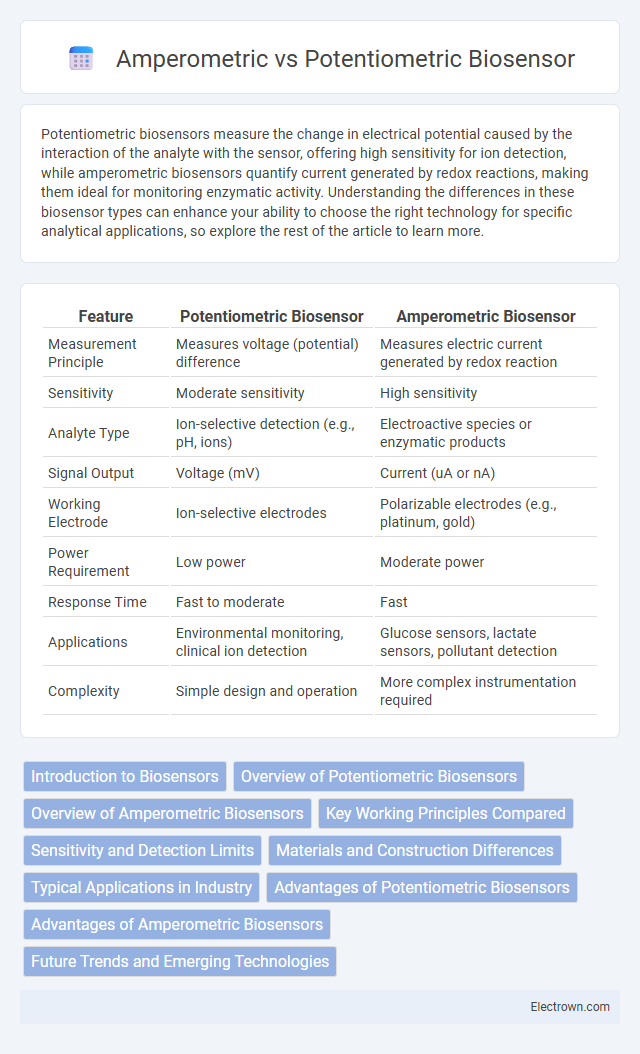Potentiometric biosensors measure the change in electrical potential caused by the interaction of the analyte with the sensor, offering high sensitivity for ion detection, while amperometric biosensors quantify current generated by redox reactions, making them ideal for monitoring enzymatic activity. Understanding the differences in these biosensor types can enhance your ability to choose the right technology for specific analytical applications, so explore the rest of the article to learn more.
Table of Comparison
| Feature | Potentiometric Biosensor | Amperometric Biosensor |
|---|---|---|
| Measurement Principle | Measures voltage (potential) difference | Measures electric current generated by redox reaction |
| Sensitivity | Moderate sensitivity | High sensitivity |
| Analyte Type | Ion-selective detection (e.g., pH, ions) | Electroactive species or enzymatic products |
| Signal Output | Voltage (mV) | Current (uA or nA) |
| Working Electrode | Ion-selective electrodes | Polarizable electrodes (e.g., platinum, gold) |
| Power Requirement | Low power | Moderate power |
| Response Time | Fast to moderate | Fast |
| Applications | Environmental monitoring, clinical ion detection | Glucose sensors, lactate sensors, pollutant detection |
| Complexity | Simple design and operation | More complex instrumentation required |
Introduction to Biosensors
Biosensors are analytical devices that combine a biological recognition element with a physicochemical transducer to detect specific analytes. Potentiometric biosensors measure the change in voltage resulting from the ion activity of the target substance, while amperometric biosensors quantify the current generated by the redox reaction of the analyte. These biosensors are widely used in medical diagnostics, environmental monitoring, and food safety for their sensitivity and specificity.
Overview of Potentiometric Biosensors
Potentiometric biosensors measure the change in electrical potential between two electrodes caused by the analyte concentration, offering high sensitivity in detecting ions and metabolites. These biosensors rely on selective ion-sensitive electrodes to provide real-time monitoring with minimal interference. Your applications benefit from their rapid response and widespread use in medical diagnostics and environmental analysis.
Overview of Amperometric Biosensors
Amperometric biosensors measure the current produced by the oxidation or reduction of an electroactive species at the electrode surface, directly correlating with the analyte concentration. These devices typically employ enzymes as biological recognition elements to catalyze specific reactions, generating measurable electric signals proportional to target molecule levels. High sensitivity and rapid response times make amperometric biosensors ideal for glucose monitoring, lactate detection, and various clinical diagnostics.
Key Working Principles Compared
Potentiometric biosensors measure the change in electrical potential between two electrodes without drawing current, relying on ion-selective electrodes to detect concentration changes of specific analytes by monitoring voltage variations. Amperometric biosensors operate by measuring the current generated from the oxidation or reduction of an electroactive species at a fixed potential, providing real-time quantification of analyte concentration through electron transfer reactions. Understanding these key working principles helps you select the appropriate biosensor type for accurate and sensitive biochemical analysis.
Sensitivity and Detection Limits
Potentiometric biosensors measure changes in the electrical potential of an analyte, providing high sensitivity for detecting ionic concentrations but often with higher detection limits compared to amperometric biosensors. Amperometric biosensors quantify current resulting from redox reactions at the electrode surface, offering superior sensitivity and lower detection limits, especially beneficial for detecting low concentrations of biomolecules. Your choice should consider that amperometric sensors typically outperform potentiometric ones when ultra-low detection limits and enhanced sensitivity are crucial for accurate analysis.
Materials and Construction Differences
Potentiometric biosensors utilize ion-selective electrodes often made from glass, polymers, or ion-selective membranes designed to measure the potential difference related to ion activity, whereas amperometric biosensors employ electrodes typically fabricated from noble metals like platinum or gold to detect current changes caused by redox reactions. The construction of potentiometric sensors centers around a reference and an indicator electrode separated by an ion-selective membrane, while amperometric biosensors consist of working, counter, and reference electrodes integrated with enzyme layers or nanomaterials to enhance electron transfer. Materials in amperometric sensors often include conductive polymers, carbon nanotubes, or graphene to improve sensitivity and signal transduction, contrasting with the primarily ion-conductive membranes used in potentiometric devices.
Typical Applications in Industry
Potentiometric biosensors are widely used in clinical diagnostics for monitoring blood pH and electrolyte levels, as well as in environmental monitoring to detect heavy metal ions. Amperometric biosensors are prevalent in the food industry for measuring glucose and lactate concentrations during fermentation processes and in pharmaceutical manufacturing for drug development and quality control. Both biosensor types are essential for continuous, real-time analysis in biotechnology and biomedical fields, offering high sensitivity and specificity for target analytes.
Advantages of Potentiometric Biosensors
Potentiometric biosensors offer high sensitivity and selectivity due to their ability to measure the potential difference generated by specific ion interactions, enabling accurate detection of low-concentration analytes. They consume minimal power since they rely on measuring voltage without requiring a constant current, making them ideal for portable and implantable devices. The simple design and rapid response time of potentiometric biosensors facilitate real-time monitoring in clinical diagnostics and environmental analysis.
Advantages of Amperometric Biosensors
Amperometric biosensors offer high sensitivity and rapid response times by measuring current generated from redox reactions, making them ideal for real-time monitoring of analytes such as glucose and lactate. Their ability to operate effectively at low potentials reduces interference from other electroactive species, enhancing specificity in complex biological samples. You benefit from their durability and straightforward miniaturization, which supports the development of portable and user-friendly diagnostic devices.
Future Trends and Emerging Technologies
Future trends in potentiometric biosensors highlight advancements in nanomaterials and microfluidic integration, enhancing sensitivity and miniaturization for point-of-care diagnostics. Amperometric biosensors are evolving with wireless data transmission and flexible electronics, enabling real-time monitoring in wearable devices. Your choice of biosensor technology will benefit from ongoing innovations that improve accuracy, portability, and user convenience.
Potentiometric vs Amperometric Biosensor Infographic

 electrown.com
electrown.com